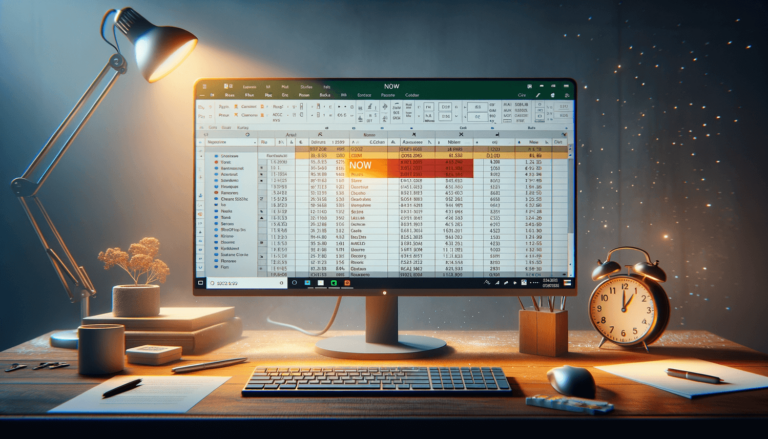

If you are looking for a quick and efficient way to insert the current date and time into your Excel spreadsheet, the NOW function is a useful tool to consider. The NOW function is a built-in date and time function in Excel that allows users to insert the current date and time into a cell. It is a simple, straightforward function that can save you time and effort by eliminating the need to manually enter the date and time. In this blog post, we will walk you through how to use the NOW function in Excel, step-by-step.
The NOW function is a built-in date and time function in Excel that displays the current date and time, updated every time the worksheet is calculated. This is a dynamic function which means that it updates automatically.
Select the cell where you want to insert the current date and time.
Type “=NOW()” (without the quotes) into the selected cell.
The NOW function displays the current date and time in a serial number format. To format the cell to display date and time in a more readable format, follow these steps:
You can use the NOW function in formulas to calculate the difference between two dates and times. Here is an example:
=NOW() - B2
The formula above subtracts the date and time in cell B2 from the current date and time displayed by the NOW function.
The NOW function in Excel is a very useful tool that can save you time and effort. By following the steps outlined in this post, you can easily insert the current date and time into your Excel spreadsheet and use it in your calculations whenever you need it.
The NOW function in Excel is an excellent tool for tracking time and dates in your spreadsheets. You can use it to calculate the difference between two dates and times, measure the time it takes to complete a task, or determine how long it has been since a specific event occurred.
You can easily calculate the difference between two dates and times in Excel by subtracting one from the other. Here is an example:
=NOW() - B2
The formula above subtracts the date and time in cell B2 from the current date and time displayed by the NOW function. You can use this formula to calculate the time it takes to complete a task or the duration between two events.
If you have a list of tasks that need to be completed and want to measure the time it takes to complete each task, you can use the NOW function in combination with other Excel functions to track your progress. Here’s how:
By using this method, you can easily track your progress and monitor how long it takes you to complete each task.
While the NOW function in Excel is a useful tool, it has a limitation. The NOW function returns the current date and time based on the system clock of your computer. This means that if the system clock on your computer is incorrect, the dates and times in your Excel spreadsheet will also be incorrect.
The NOW function in Excel can be an incredibly helpful tool for tracking time and dates in your spreadsheets. Whether you’re using it to calculate the duration between two events or monitor the time it takes to complete a task, it can save you time and effort. However, it is essential to keep in mind the limitation of the NOW function and ensure that the system clock on your computer is up to date.
Here are some of the most commonly asked questions about using the NOW function in Excel:
A: Yes, you can change the format of the date and time displayed by the NOW function in Excel. Select the cell containing the NOW function, then click on the “Home” tab and select a date or time format from the “Number” tab.
A: Yes, the NOW function can be used to automatically update the date and time in your Excel workbook. The function is dynamic, which means it updates every time the worksheet is calculated.
A: The NOW function in Excel displays both the date and time, while the TODAY function only displays the current date.
A: Yes, the NOW function can be used in conditional formatting in Excel. For example, you can use it to highlight cells that are older than a certain date or time.
A: Yes, the NOW function can be used in a formula to calculate the age of a person or item. Subtract the date of birth or date of creation from the current date and time displayed by the NOW function to calculate the age. However, keep in mind that the accuracy of the age calculation depends on the accuracy of the system clock on your computer.
Explore the world of Microsoft PowerPoint with LearnPowerpoint.io, where we provide tailored tutorials and valuable tips to transform your presentation skills and clarify PowerPoint for enthusiasts and professionals alike.

Your ultimate guide to mastering Microsoft Word! Dive into our extensive collection of tutorials and tips designed to make Word simple and effective for users of all skill levels.

Boost your brand's online presence with Resultris Content Marketing Subscriptions. Enjoy high-quality, on-demand content marketing services to grow your business.
